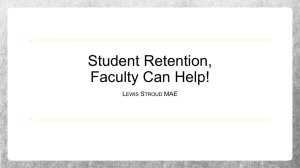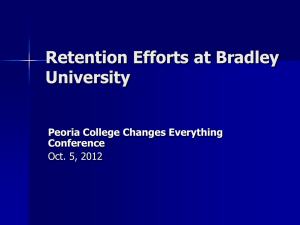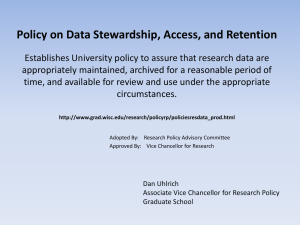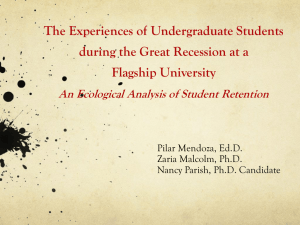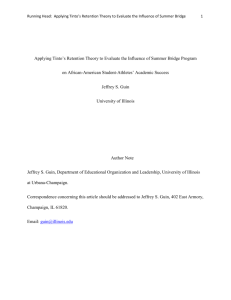ORGANIC RETENTION - Oakland University
advertisement
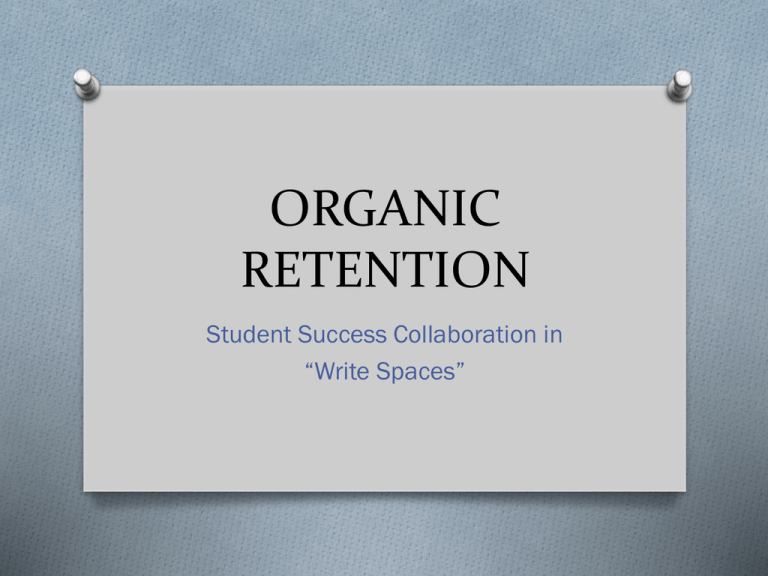
ORGANIC RETENTION Student Success Collaboration in “Write Spaces” Facilitators Sherry Wynn Perdue, Director Oakland University Writing Center Rochester, MI wynn@oakland.edu Kim Ballard, Director Western Michigan University Writing Center Kalamazoo, MI kim.ballard@wmich.edu Session Abstract Tinto (2012) and others maintain that student success is correlated with clear and consistent institutional expectations; personal, social, and academic support; and collaboration among faculty, staff, and students. These criteria also describe many campus writing interventions that connect firstyear, first-generation, international, veteran, returning, and other students with academic success. Prime sites for organic retention, these units operationalize local values while facilitating students’ critical reading and writing skills and their confidence for each new writing task. This presentation highlights the retention power inherent in the “write spaces” of our campuses. Presenters will discuss how such programs enact the retention strategies Tinto and others laud and will share results of a multi-campus survey, which documents wide-spread retention efforts. Audience members will gain ideas for collaborating with campus-based “write spaces” to grow cost-effective, organic retention efforts that also advance student learning and faculty development. Workshop Agenda Part 1: Participant Survey Part 2: Workshop Goal Part 3: Definition and Touchstones: Organic Retention Part 4: Tinto’s Framework for Student Success and its Relationship to Writing Center Work Part 5: Specific Writing Center Retention Efforts Part 6: Writing Center Research on Retention Part 7: Concluding Survey Part 8: References Participant Survey O What group(s) of students on your campus most present retention risks? O What resources might your institution supply or enhance to retain more students and to ensure that students develop key abilities (critical thinking, writing, quantitative reasoning, etc.)? O Does your institution host a writing center? What roles (if any) do you think writing centers play in retention? Workshop Goals O We seek to raise awareness about roles writing centers historically have played, currently play, and potentially might play in retention. O We maintain that the organizational chart should not disenfranchise an important student success resource, although writing centers are generally housed in Academic Affairs, whereas retention efforts are traditionally spearheaded in Student Affairs. O We suggest inviting writing center personnel into this important conversation about student success if higher education stakeholders like you hope to decrease attrition on your campuses. Organic Retention Local campus strategies that, while employing theory and research from the literature on retention and higher education, respond to the needs of students as contextualized in a specific institution. Tinto’s Student Success Framework O Expectations O Support O Assessment and Feedback O Involvement Writing Center History O Extension of classroom learning O Remediation offered for underprepared in response to the changing entering class at different historical times (Veteran enrollment under GI Bill, Open Admissions, Civil Rights, etc.) Writing Center Retention Initiatives O In-the Center (Writing Center Pedagogy) O Embedded Classroom Interventions O Targeted Services for Specific Populations/Settings, such as Graduate students Developmental writers High-attrition courses Tenure Stream Faculty Non-native Speakers Emotionally and developmentally disabled students Writing Center Research on Retention O Research that defines that writing center’s role in retention O Research that demonstrates initial findings in support of the writing center’s efficacy in mediating attrition O Research that addresses methodological complexity in documenting persistence Concluding Survey O How can you envision partnering with or leveraging your institution’s writing center? O If you do not have one, list reasons why you might want to found one to redress attrition. References Bell, D. C., & Frost, A. (2012). Critical inquiry Haswell, R. (2001). Beyond Outcomes: and writing centers: A methodology of Assessment and Instruction within a assessment. The Learning Assistance University Writing Program. Westport, CT: Review, 17(1), 15-26. Ablex Publishing. Boquet, E. H. (1999). “Our little secret’: A Griswold, G. (2003, Dec.). Writing centers: The history of writing centers, pre- to post-open student retention connection. Academic admissions. College Composition and Exchange Quarterly. Communication, 50(3), 463-482. Poziwilko, L. (1997). Writing centers, Broad, B., Adler-Kassner, L., Aldord, B., retention, and the institution: A fortuitous Detweler, J., Estrem, H., Harrington, S., . . . nexus. Writing Lab Newsletter, 22(2), 1-4. Weeden, S. (2009). Dynamic criteria Reason, R. D. (2009). An examination of mapping in action: Organic writing persistence research through the lens of a assessment. Logan, Utah: Utah State comprehensive conceptual framework. University Press. Journal of College Student Development, Carino, P. (1995). Early writing centers: 50(6), 659-682. Toward a history. Writing Center Journal, Simpson, J. The role of writing centers in 15(2), 103-115. student retention programs. In R. Wallace Carino, P. (1996). Open admissions and the (Ed.), The writing center: New directions construction of writing center history: A tale (pp. 102-109). New York: Garland of three models. Writing Center Journal, Publishing. 17(1), 30-48. Tinto, V. (2012). Completing college: Guba, E. G. & Lincoln, Y. S. (1989). Fourth Rethinking institutional action. Chicago, IL: generation evaluation. Newbury Park, CA: University of Chicago Press. Sage Publishing. Access This presentation can be accessed at: www.oakland.edu/presentations.

